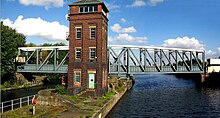Bridgewater Canal
| Bridgewater Canal (main line) | |
|---|---|
| location | North West England |
| length | approx. 45 km |
| Descent structures | without |
Opened in 1761, the Bridgewater Canal is a canal in north-west England built for canal boats up to 4.5 meters (14 feet 9 inches) wide, first led to Manchester by the Duke of Bridgewater's coal mines near Worsley and later extended to Runcorn . Since it was built on the same level without any locks , the width restriction of 7 feet (2.13 m) chosen for later canals with tunnels and numerous locks was not necessary.
The Barton Aqueduct , which originally led the canal across the River Irwell , was then perceived as a technical wonder of the world. The Barton Swing Aqueduct has stood in its place since 1893 .
route
The canal originally ended in Castlefield Basin, where the boats used as inland cargo ships unloaded their cargo destined for the city of Manchester. The Rochdale Canal, which has been running in a north-easterly direction through Manchester's city center, has started here since 1804 .
From Castlefield, the canal initially runs 7 km west to the Watersmeet canal junction. He passes the now decommissioned Hulme lock, which once provided a connection to the River Irwell and the Manchester Ship Canal . A recent lock at Pomona now connects the Bridgewater Canal with the Manchester Ship Canal.
At Waters Meeting, the channel branches out. The original canal runs 10 miles northwest to the village of Worsley and the local coal mine of Francis Egerton, 3rd Duke of Bridgewater , who initiated and financed the construction of the canal that bears his name. On this section, the canal at Eccles also crosses the Manchester Ship Canal by means of the Barton Swing Aqueduct . This section of the canal was extended by 8 km to Leigh in 1799 to connect to the Leeds and Liverpool Canal .
Today's main canal, which technically and historically actually represents a later extension to the section of the canal described above, leads from Waters Meeting for about 32 km southwest to Runcorn . This section of the canal passes the towns of Sale and Lymm in the center, the town of Warrington to the south and at the junction at Preston Brook near Runcorn there is a short junction with the Trent-Mersey Canal .
The canal ends in the Runcorn Basin today. The locks, which once led from there to the River Mersey and later to the Manchester Ship Canal and the docks there, were closed in the mid-1960s. A private association, the Runcorn Locks Restoration Society , is trying to restore and reopen the locks.
history
The Bridgewater Canal is known as the first “modern” canal in England, because it was an artificially created waterway that only used existing watercourses for water supply and not only expanded them into a navigable waterway.
The Bridgewater Canal was built because Francis Egerton, 3rd Duke of Bridgewater, was looking for an efficient route to transport coal from his coal mines at Worsley to Manchester , where the Industrial Revolution was causing great upheaval. The canal was led into the underground coal mine by means of a canal tunnel and also solved the problem of mine drainage. The coal did not have to be conveyed to the surface via a vertical shaft, but could already be loaded underground into the canal boats.
The Duke commissioned James Brindley to build the canal, which could be completed by 1761. At the time, the construction of the canal was considered a great feat of engineering that made Brindley the most sought-after canal engineer of the day.
But the Duke of Bridgewater also got his money's worth. He had invested approximately £ 200,000 in building the canal and earned £ 80,000 annually from operating the canal. This immense economic success led to the so-called canalmania . Due to the easier coal transport to Manchester and consequently the increasing supply, the coal price fell by three quarters in Manchester within a year of the opening of the canal.
Within the coal mine there were still over 70 km of underground canals on a total of four levels, some of which were connected to one another by a ship lift in the form of an inclined elevator . These were navigated with smaller barges that could transport a payload of up to 12 t. In 1887 the mine was finally abandoned.
Until about 1975 there was still commercial freight traffic on the Bridgewater Canal, since then it has been reserved for recreational boating with the modern narrowboats designed as floating holiday homes . For this purpose, the Bridgewater Canal forms an essential part of the Cheshire Ring, a canal circuit through Cheshire.
The Bridgewater is one of the few canals that have never been nationalized. It is still owned by the private Manchester Ship Canal Company.
See also
bibliography
- Hugh McKnight: The Shell Book of Inland Waterways . 2nd Edition. David & Charles PLC, 1981, ISBN 978-0-7153-8239-4 .
- Michael E. Ware: Britain's lost waterways . Moorland, 1989, ISBN 0-86190-327-7 .
- Francis Henry Egerton: Description du Plan Incliné Souterrain ( description of the underground ship lift ), online version on Google Books
Web links
- Website of The Manchester Ship Canal Company on the Bridgewater Channel (English)
- Website with description and photographs
- Duke of Bridgewater Archive from the University of Salford site
- Duke of Bridgewater's Underground Canal at Worsley ( September 24, 2006 memento in the Internet Archive )
- Astley Green Colliery Museum
- Manchester Ship Canal Company website
Individual evidence
- ↑ Archive link ( Memento of the original from April 4, 2013 in the Internet Archive ) Info: The archive link was inserted automatically and has not yet been checked. Please check the original and archive link according to the instructions and then remove this notice.


